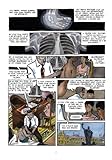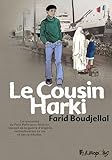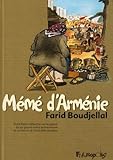Sixteen years after the French conquest in 1830, unlike Morocco and Tunisia, Algeria had become an integral, legal and administrative part of metropolitan France. The seating of French colonial power and the terrible scars born of the ethnic hierarchy (implicit to the French colonial-settler model) ran and still run extremely deep historically, linguistically and psychologically on both sides of the Mediterranean.
Algerian independence from France was achieved 50 years ago. Self-determination occurred after a gruesome and bloody war lasting eight years until 1962, the year in which over a million Français d’Algérie (French Algerians or Pied-Noirs) fled the country. Among them were indigenous Jews and Muslim Harkis, (from the Arabic Haraka or movement), the generic name defining Muslim Algerians involved, in any way, with the French army. These men and women, often through no fault of their own, found themselves re-classified by the victors as traitors to the nationalist cause and were forced to take flight. Subsequently, the ‘repatriates’ often came into contact with waves of Algerian economic migrants upon their arrival in the infamous, marginal, outer and inner city suburbs (banlieues) of urban France. So, whilst today Algeria celebrates the 50th anniversary of liberation, France continues to struggle under the weight of its colonial past.
Since the emergence of a literate and politicized second generation of French-born North Africans in the 1980s, official French channels of communication have strived unsuccessfully to deal with the ingrained modes of discrimination that were learnt, reinforced and which proliferated during the long colonial period. Some scholars and intellectuals consider that contemporary metropolitan France replicates a colonial model within its own borders. Others, often of Algerian origin themselves, endeavor to re-write the history of the two countries from the vantage point of the previously colonized in order perhaps to improve understanding between people and give voice to the pain and suffering that has been endured. From a demographic perspective, it is estimated that, in one way or another, approximately 10% of the French population has a familial connection and therefore a probable affective relationship to Algeria thus giving cultural production regarding Franco-Algerian relations a wide-ranging francophone audience.
Actor and recipient of this deranged history and impossible bond, Farid Boudjellal is an artist born in 1953, into an Algerian family (though his paternal grandmother was Armenian) who settled in a poor neighborhood of Toulon in South Eastern France. A semi-autobiography, the classically drawn and water-painted Petit Polio, is a four-part graphic novel series based on Boudjellal's childhood. The author is incarnated by Mahmoud Slimani, aka Le Petit Polio, an endearing child character born of "a world founded and imagined" by Boudjellal. The likeable boy is clad in shorts and a leg brace and serves as a kind of “narcissistic substitute”(1) for the author. As a baby, Farid contracted poliomyelitis (polio) and his pudding-bowl doppelganger Mahmoud suffers from the same condition. In the first two graphic novels of the collection: Petit Polio (Little Polio) and Mémé d'Armenie (Granny from Armenia) the struggle with the scars of Polio, the fight for peer acceptance and the more everyday difficulties of childhood are told through Mahmoud’s innocent ‘eyewitness account’ against the backdrop of the War of Algerian Independence in France.
By associating the questions of ethnicity and disability within Mahmoud’s everyday experience, Boudjellal is able to show both the systemic State marginalization of both the sick and of the immigrants. Consequently, the graphic novels highlight the parallel disadvantages of physical and ethnic difference in France. Yet despite the bleak subject matter, the Le Petit Polio series paints an optimistic picture of life and Boudjellal inscribes the positivity of being an exception (having found cartoons at an early age) in France into an ongoing process of franco-maghrebi cultural fusion and invention. The aesthetics of French-Algerian hybridity and its lived normalcy is a running theme in the Le Petit Polio series. Indeed, it is through humour and wit, depicted in abundance, that Mahmoud finds the ability to face his physical challenge. His friendships and the solidarity shown by those around him are testimony to the author’s faith in humanity whilst he uses the introverted creative world of the artist to escape, often to comic effect.
"Little Mahmoud has mislaid his orthopedic shoe!"
Growing up, the author suffered from acute asthma and his mother exclaims, “Polio, Peritonitis, Bronchitis, Jaundice, Mumps, Whooping cough... when crap falls, it always falls on Mahmoud.”(2) For Mahmoud though, every cloud has its silver lining and he finds that, taken in enough quantity, the bronchodilator drugs contained in Asthma inhalers can get you high. Consequently, an asthma crisis and an inhaler overdose, which almost give him a heart attack culminate in Mahmoud’s internment into a health institution (La Clinique called Les Jours Plissés). The experiences at the Clinique which go on to bring him into closer contact with 1960s French society show how Boudjellal’s political consciousness was formed and are featured heavily in the second two graphic novels of the series: Les Années Ventoline (The Inhaler Years) and Le Cousin Harki (the Harki cousin), that was published in 2012.
From My Harki Cousin. Three pictures of Emir Abd al Kader running from left to right. i. "Who's the guy on the poster? Is it Frank Zappa with a Djellaba?" ii. "He was born in the 19th century but it was as if he came straight out of the 15th - the time of Arab greatness - he was a combattant, poet, philosopher and spiritual guide" iii."He caused a lot of problems for the French colonial army for 15 years until he was captured and incarcerated at Chateau Ambroise"
Boudjellal's art-work concerning Mahmoud's infancy and formative years is colorful, elegant but traditional which stands in stark opposition to the unorthodox lack of linguistic barriers in the text. The transliterated southern accent is present in the speech of Mahmoud, his friends and his sisters. Furthermore, the use of Arabic and Armenian characters in the novels seem to demonstrate the impenetrability of foreign tongues, an indiscernible secret code for those on the outside, graphically highlighting the ostensible difference of written language. Curiously, the author attributes thanks to others for the transcriptions into Armenian and Arabic characters in his graphic novels, perhaps indicating that he himself has difficulties in deciphering the alphabets of languages with which he has an intimate relationship, a common feature of second-generation alienation from their heritage. Indeed, whilst the night prayers of his Armenian grandmother are shrouded in mystery and magic, the meaningful murmuring of his mother that he uses to calm his suicidal friend are given a folklorish status among his friends in the Clinique because of their magnificent opacity. Such a deep-rooted and contradictory sense of the vulnerability and the potential of transnational linguistic and cultural mixity in the natural course of lived experience are organic leitmotifs from which Boudjellal draws throughout the stories.
From Grandma from Armenia. Prayer transcribed in Armenian script
From My Harki Cousin penultimate strip: i. "Calm yourself, calm yourself ii.(arb.) "Don't worry... ii.(arb.) my brother... iii. (arb.) ...if I had a father, I would love him so much"
The first two graphic novels in the series were originally published by Soleil, a non-mainstream publishing house owned by Farid’s brother Mourad towards the end of the 1990s. The idea for the series was spawned from a conscious desire, on behalf of the artist, to become an ‘author-artist’ (auteur) and take ownership of his text and image. Furthermore, after his involvement in the anti-racist movement of the 1980s and his artistic engagement in expressing the importance of North African identity politics (see for example “Les Beurs”), his decision to draw and write semi autobiographically coincided with the political electoral rise of the far right Front National group in his home-town, Toulon. The Harki Cousin, the last graphic novel in the Le Petit Polio series, which is Boudjellal’s most recent, corresponds to what Algerian public intellectual Mohamed Harbi calls "the proliferation of (colonial) micro histories" running parallel to a postcolonial coming to terms with the colonial past in French society (3) that such work helps to strengthen by straddling histories, experiences and emotions taken from the colonial and postcolonial periods in France. A further indication of the growing socio-cultural importance attached to such artistic representations of these complicated histories is Boudjellal’s passage to a better established publishing house...
Boudjellal’s characters no doubt resemble people who he has met, befriended and lived among, but equally many of them also signify particular French Imperial historical conjunctures. These ‘character-tropes’, that also constitute Boudjellal’s social world, are especially present in The Inhaler Years and The Harki Cousin. Daniel Hossner, the Director of the Hospital or “Morse”, as he is referred to by the younger in-patients, is a mysterious character introduced and developed with empathy by way of his peculiar tick - he taps out Morse-code messages of fondness to his patients... Doctor Hossner believes in strengthening the body and the mind in order to heal the respiratory disorders particularly associated with trauma and stress. His tragic life story is slowly revealed in The Harki Cousin as his personal trajectory coincides with the life stories of the Colonel, who converted to Islam, Jean-René Martin (known as Tahar) and Moktar, the Harki cousin who arrives at the Clinique to finish writing a thesis on the Emir Abdelkader (a prominent figure in Algerian history, famous for having led a struggle against the French in the mid-nineteenth century). In their own ways, each of these characters’ lives represents a blemish in the forlorn Imperial history of contemporary France: the Vichy laws that disempowered Jewish people, deportation and the enlisting of Muslim Algerians into the army (many of whom would become Harki). Nevertheless, the pain of these horror-stories is always finely balanced with Boudjallel’s deep-seated optimism in humankind. The strength, courage and sensitivity of the characters Jean-Réné, Daniel and Moktar formulate an image of France that allows for a context in which creativity and religious syncretism can exist and subsequently lend hope for the future.
From My Harki Cousin penultimate strip: "I don't at all regret having assisted that strange Muslim funeral in a Christian Chapel in the Clinique. The General was after all a Catholic before he became a Muslim. The decor did not stop the Imam from conducting his office. Daniel stood behind me I could hear his hand frantically tapping on his leg."
Whilst the earlier two works cover the political historical realities that occured during Mahmoud’s infancy, the subject of memory and its transmission is evoked in the story of Dr Robert Rankounian’s relationship with Mme Slimani, Mahmoud’s Armenian grandmother. When they meet he tells her: “that’s one of the paradoxes of your generation and mine... you want to forget what you lived through whereas we want to remember it...”
Boudjellal’s work, himself having lived on the cusp of the pre and post Algerian war of Independence generations, depicts the traumatic scars of Jewish deportation in France, the memories of the Armenian genocide in Turkey and the brutality of the Algerian War of Independence sensitively from the perspective of both past and present generations. Only too aware of the power of historical re-appropriation within postcolonial nationalism, the author subtly illustrates the dangers of obsessing over the past. In an interview for ActuaBD the author explained the importance of empathy in his work. When he “draws a Jew,” he considers himself a Jew, and “the same goes for a Muslim," or an Armenian for that matter. The mix of heartfelt sensitivity and the gritty humor of survival punctuate the subjacent discussion on disability and its treatment within society in the novels.
Finally, the significant historical moments that Mahmoud lives through in the graphic novels, that presumably constitute part of Boudjellal’s own personal remembered history, are often tinged with amusing anecdotes. For example, when the General De Gaulle visits Toulon in 1958, Mahmoud draws and signs a caricature of him to show his friends in the crowd, only to see his slip of paper grasped from him and tossed into the air by Le Mistral (the strong southerly winds that blow in Provence). The drawing somehow finds its way into the General’s coat pocket, who declares upon finding it later that evening, that “Mahmoud has a brilliant future as a caricaturist ahead of him.” The implication is clear, an image and the message it carries can be easily transported and find its way into the hands of any number of people in any number of positions of power. Should the nascent positive reception that Boudjellal’s work has been receiving in France continue to grow, perhaps the message of optimism, humor in adversity and hope that the Le Petit Polio series depicts will help to build a more psychologically harmonious and human Franco-Algerian future conscious of the past and the frequent opacity of its communication but equally aware that history is plural, personal and emotional in nature.
Endnotes:
1 Farid Boudjellal, Mouloud Boukala, Charles Gardou, and Mouloud Boukala. “Petit Corps Malade.” Reliance 25, no. 3 (2007): 115.
2 Mahmoud’s mother talking to her husband uses the French expression “une merde lui est tomber dessus” – mix of bad luck and inevitable fate.
3. Benjamin Stora, Mohammed Harbi, and Collectif. La Guerre d’Algérie?: 1954-2004 , La Fin De L’amnésie. Robert Laffont, 2004.




